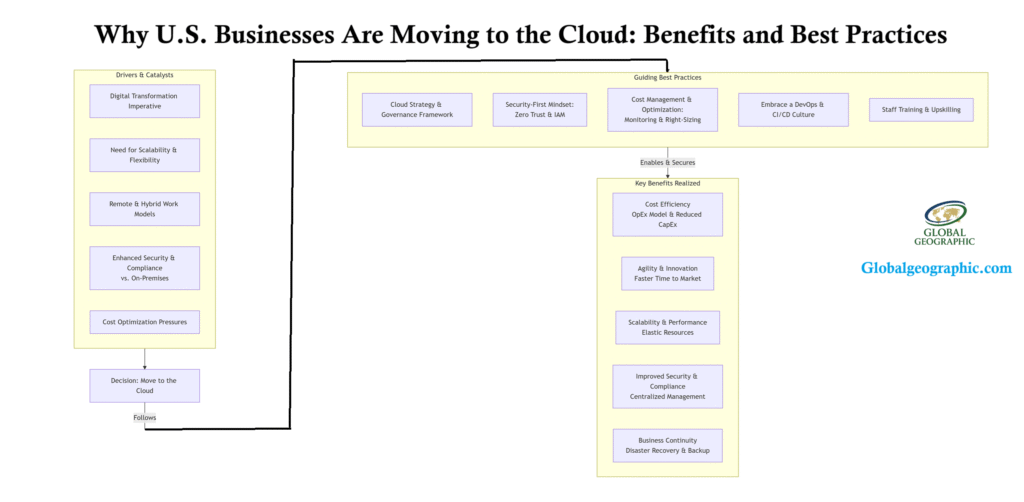
Why U.S. Businesses Are Moving to the Cloud: Benefits and Best Practices
By Sameer C, Co-Founder, Global Geographic Inc.
The way U.S. businesses operate has fundamentally changed over the past decade. Remote work, global collaboration, massive data growth, and rising customer expectations are forcing organizations to rethink their IT strategies. At the heart of this transformation lies one critical decision: the move to the cloud.
Cloud adoption in the United States has surged across industries, from startups to Fortune 500 companies. According to Gartner, more than 85% of enterprises worldwide will embrace a cloud-first principle by 2025. In my own 15+ years of consulting, I’ve witnessed this shift firsthand. Businesses that embrace the cloud not only modernize their infrastructure but also gain the agility to respond to market challenges faster.
So, why are U.S. businesses moving to the cloud, and how can they do it right? Let’s break it down.
Benefits of Moving to the Cloud
1. Cost Efficiency and Flexibility
Traditional IT infrastructure requires significant upfront investment in servers, hardware, and maintenance. The cloud flips this model, offering a pay-as-you-go approach. Businesses only pay for the resources they use, making it possible to scale up or down depending on demand.
This is especially valuable for U.S. small and mid-sized businesses (SMBs) that want enterprise-grade infrastructure without heavy capital expenditure.
2. Scalability and Agility
Whether it’s a sudden surge in e-commerce traffic during the holiday season or supporting a fast-growing customer base, the cloud enables businesses to scale resources instantly. This on-demand scalability is something traditional infrastructure simply cannot match.
For startups and growing businesses in the U.S., scalability is the difference between seizing opportunities and missing them.
3. Remote Work Enablement
The COVID-19 pandemic accelerated a long-term trend: remote and hybrid work. Cloud solutions like Microsoft 365, Google Workspace, and AWS allow teams to collaborate securely from anywhere. For U.S. businesses managing geographically distributed teams, the cloud ensures employees can access files, applications, and data without being tied to a physical office.
4. Enhanced Security
Cybersecurity is a top concern for every U.S. company. While some organizations still hesitate to trust the cloud with sensitive data, the reality is that leading providers like AWS, Azure, and Google Cloud invest billions annually in advanced security infrastructure.
Features such as multi-factor authentication, encryption, and continuous monitoring give businesses stronger defenses than most could afford to implement on their own.
5. Innovation and Competitive Advantage
Cloud platforms offer access to cutting-edge technologies like AI, machine learning, advanced analytics, and IoT integration. Businesses can leverage these tools without needing in-house expertise to build them from scratch.
For example, a U.S. retail company can use cloud-based analytics to study customer behavior in real time, driving smarter marketing campaigns and increasing sales.
6. Disaster Recovery and Business Continuity
Disasters — whether natural, cyber, or operational — are a reality every business must prepare for. Cloud services provide automated backups, data redundancy, and quick recovery options, ensuring minimal downtime. For American companies competing in fast-moving markets, this resilience is essential.
Best Practices for Cloud Adoption in the U.S.
While the benefits are clear, moving to the cloud requires a thoughtful strategy. Here are some best practices I recommend to clients at Global Geographic Inc.:
1. Define Your Business Objectives First
Don’t move to the cloud just because it’s a trend. Identify what you want to achieve: reducing costs, enabling remote work, improving scalability, or enhancing analytics. Clear objectives help guide vendor selection and deployment strategies.
2. Choose the Right Cloud Model
- Public Cloud: Cost-effective, scalable, and ideal for most businesses.
- Private Cloud: Greater control and customization for industries with strict compliance needs.
- Hybrid Cloud: A mix of both, offering flexibility and security.
Each model has pros and cons. For example, financial institutions in the U.S. often choose hybrid models to balance compliance with scalability.
3. Prioritize Security and Compliance
With regulations like HIPAA, SOX, and CCPA, U.S. businesses must ensure cloud adoption aligns with compliance requirements. Choose vendors that provide robust security certifications and industry compliance standards.
4. Invest in Employee Training
A successful cloud strategy isn’t just about technology — it’s about people. Employees must be trained on new workflows, collaboration tools, and security practices. At Global Geographic Inc., we emphasize continuous learning because adoption fails when teams lack confidence in using the tools.
5. Plan for Integration
Most businesses already use legacy systems. When moving to the cloud, plan for seamless integration with existing applications. This ensures business continuity and avoids disruption.
6. Monitor and Optimize Continuously
Cloud adoption isn’t a one-time event. Businesses must monitor usage, track costs, and optimize resources regularly. Analytics and reporting tools within cloud platforms provide the visibility needed to fine-tune performance.
The move to the cloud is not just a technology shift — it’s a strategic transformation. U.S. businesses adopting cloud solutions are reaping the rewards of flexibility, security, and innovation while positioning themselves for future growth.
At Global Geographic Inc., we’ve seen how cloud adoption empowers organizations to modernize operations, improve resilience, and stay competitive in an ever-changing marketplace. Our mission is to guide businesses and professionals through these transitions with the right knowledge, tools, and training.
For business leaders considering the cloud, my advice is simple: start with your goals, plan carefully, and invest in your people. With the right approach, cloud adoption won’t just modernize your IT — it will transform your entire business.